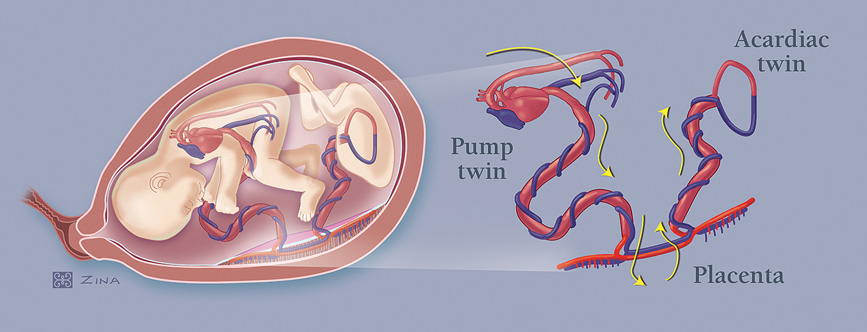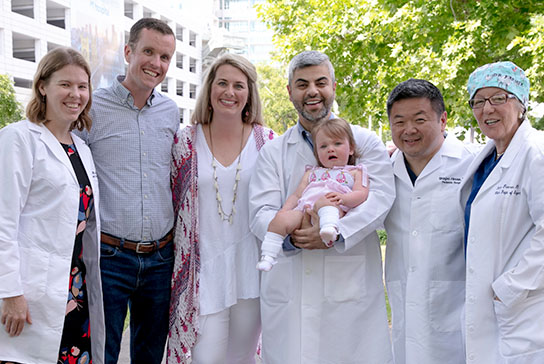Fetal Care and Treatment Center
Twin reversed arterial perfusion syndrome

What is twin reversed arterial perfusion syndrome?
Twin-reversed arterial perfusion syndrome is a rare condition occurring in approximately one percent of monochorionic twin pregnancies, or twins that share one placenta.
One twin, usually structurally normal, is referred to as the “pump twin” because his/her heart is used to pump blood to the other twin. The other twin, called the “acardiac twin,” is abnormal, usually consisting of only legs and a lower body but no head, upper body or heart. It relies upon the normal twin for circulation, putting the pump fetus at risk of heart failure.
Because the normal pump twin’s heart must work extra hard and is at risk of heart failure. Left untreated, up to 50 percent of these otherwise normal twins die in utero or shortly after birth.
Diagnosis
The condition is detected during routine ultrasound during pregnancy. Doppler imaging can detect the vascular abnormalities and confirm the diagnosis.
Treatment
Treatment during pregnancy focuses on safely stopping flow to the acardiac mass so that the normal pump twin and his/her heart is protected. The most successful treatment involves a procedure called radiofrequency ablation. During this treatment, a surgeon uses real-time ultrasound guidance to place the ablation device through the mom’s abdomen and uterus and into the acardiac abdomen. Energy is deployed through the tip of the device to clot the vessels to the acardiac twin, stopping blood flow.
The major benefit of this technique is the extremely small size of the instrument used, typically leading to few or no complications for the mom.
Outcomes
The surviving twin will be completely evaluated at birth, especially for the health of his/her heart and brain. With prenatal treatment and term or near-term delivery, most do very well. All children with twin-reversed arterial perfusion syndrome should be born at a hospital with a team skilled with high-risk births and neonatal care.
Contact us or make a referral
Physicians, patients and families can contact the Fetal Care and Treatment Center to find out more about our fetal care services.
Wondering about what types of conditions should be referred to us? View list of conditions to refer.
Referring physicians from other facilities, please use our Fetal Care and Treatment Center Referral form to refer patients and request services.
UC Davis Children’s Hospital
4301 X Street, 1st Floor, Suite 1501
Sacramento, CA 95817
The Fetal Care and Treatment Center is located within UC Davis Children’s Hospital.
View map and directionsarrow_forward

